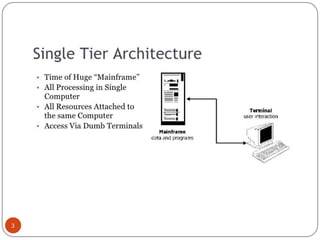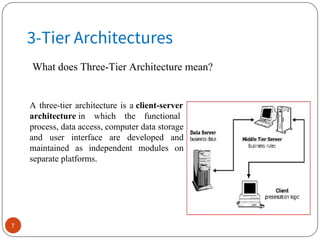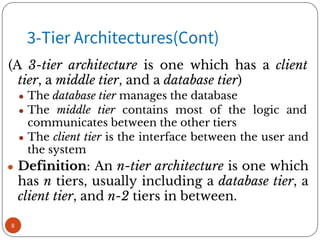ANSI-SPARC Architecture - (3-Tier Architecture)
- 1. 1 3-Tier Architecture Name : Yaksh Jethva yakshjethva_123@yahoo.com
- 2. 2
- 3. 3
- 4. 4
- 5. 5
- 6. 6
- 7. 7 3-Tier Architectures What does Three-Tier Architecture mean? A three-tier architecture is a client-server architecture in which the functional process, data access, computer data storage and user interface are developed and maintained as independent modules on separate platforms.
- 8. 3-Tier Architectures(Cont) 8 (A 3-tier architecture is one which has a client tier, a middle tier, and a database tier) ¡ñ The database tier manages the database ¡ñ The middle tier contains most of the logic and communicates between the other tiers ¡ñ The client tier is the interface between the user and the system ¡ñ Definition: An n-tier architecture is one which has n tiers, usually including a database tier, a client tier, and n-2 tiers in between.
- 9. 9 ?Presentation Tier: Occupies the top level and displays information related to services available on a website. This tier communicates with other tiers by sending results to the browser and other tiers in the network. ?Application Tier: Also called the middle tier, logic tier, business logic or logic tier, this tier is pulled from the presentation tier. It controls application functionality by performing detailed processing. ?Data Tier: Houses database servers where information is stored and retrieved. Data in this tier is kept independent of application servers or business logic. 3-Tier Architectures
- 10. 10
- 11. 11
- 12. Thank You!!! 12












